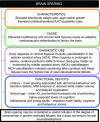The consequences of fetal growth restriction on brain structure and neurodevelopmental outcome
- PMID: 26607046
- PMCID: PMC4753264
- DOI: 10.1113/JP271402
The consequences of fetal growth restriction on brain structure and neurodevelopmental outcome
Abstract
Fetal growth restriction (FGR) is a significant complication of pregnancy describing a fetus that does not grow to full potential due to pathological compromise. FGR affects 3-9% of pregnancies in high-income countries, and is a leading cause of perinatal mortality and morbidity. Placental insufficiency is the principal cause of FGR, resulting in chronic fetal hypoxia. This hypoxia induces a fetal adaptive response of cardiac output redistribution to favour vital organs, including the brain, and is in consequence called brain sparing. Despite this, it is now apparent that brain sparing does not ensure normal brain development in growth-restricted fetuses. In this review we have brought together available evidence from human and experimental animal studies to describe the complex changes in brain structure and function that occur as a consequence of FGR. In both humans and animals, neurodevelopmental outcomes are influenced by the timing of the onset of FGR, the severity of FGR, and gestational age at delivery. FGR is broadly associated with reduced total brain volume and altered cortical volume and structure, decreased total number of cells and myelination deficits. Brain connectivity is also impaired, evidenced by neuronal migration deficits, reduced dendritic processes, and less efficient networks with decreased long-range connections. Subsequent to these structural alterations, short- and long-term functional consequences have been described in school children who had FGR, most commonly including problems in motor skills, cognition, memory and neuropsychological dysfunctions.
© 2015 The Authors. The Journal of Physiology © 2015 The Physiological Society.
Figures



Similar articles
-
Early- versus Late-Onset Fetal Growth Restriction Differentially Affects the Development of the Fetal Sheep Brain.Dev Neurosci. 2017;39(1-4):141-155. doi: 10.1159/000456542. Epub 2017 Mar 9. Dev Neurosci. 2017. PMID: 28273661
-
Altered trajectory of neurodevelopment associated with fetal growth restriction.Exp Neurol. 2022 Jan;347:113885. doi: 10.1016/j.expneurol.2021.113885. Epub 2021 Oct 7. Exp Neurol. 2022. PMID: 34627856 Review.
-
Detection and assessment of brain injury in the growth-restricted fetus and neonate.Pediatr Res. 2017 Aug;82(2):184-193. doi: 10.1038/pr.2017.37. Epub 2017 May 17. Pediatr Res. 2017. PMID: 28234891 Review.
-
Perinatal changes in cardiac geometry and function in growth-restricted fetuses at term.Ultrasound Obstet Gynecol. 2019 May;53(5):655-662. doi: 10.1002/uog.19193. Epub 2019 Apr 9. Ultrasound Obstet Gynecol. 2019. PMID: 30084123
-
Cardiac function in fetal growth restriction.Minerva Obstet Gynecol. 2021 Aug;73(4):423-434. doi: 10.23736/S2724-606X.21.04787-0. Epub 2021 Apr 27. Minerva Obstet Gynecol. 2021. PMID: 33904691 Review.
Cited by
-
Antenatal low-intensity pulsed ultrasound reduces neurobehavioral deficits and brain injury following dexamethasone-induced intrauterine growth restriction.Brain Pathol. 2021 Nov;31(6):e12968. doi: 10.1111/bpa.12968. Epub 2021 May 7. Brain Pathol. 2021. PMID: 33960564 Free PMC article.
-
Current practice in the diagnosis and management of fetal growth restriction: An international survey.Acta Obstet Gynecol Scand. 2022 Dec;101(12):1431-1439. doi: 10.1111/aogs.14466. Epub 2022 Oct 10. Acta Obstet Gynecol Scand. 2022. PMID: 36214456 Free PMC article.
-
Adjusting growth standards for fetal sex improves correlation of small babies with stillbirth and adverse perinatal outcomes: A state-wide population study.PLoS One. 2022 Oct 10;17(10):e0274521. doi: 10.1371/journal.pone.0274521. eCollection 2022. PLoS One. 2022. PMID: 36215239 Free PMC article.
-
Neuroprotective Action of Tacrolimus before and after Onset of Neonatal Hypoxic-Ischaemic Brain Injury in Rats.Cells. 2023 Nov 20;12(22):2659. doi: 10.3390/cells12222659. Cells. 2023. PMID: 37998394 Free PMC article.
-
Advanced MRI analysis to detect white matter brain injury in growth restricted newborn lambs.Neuroimage Clin. 2019;24:101991. doi: 10.1016/j.nicl.2019.101991. Epub 2019 Aug 23. Neuroimage Clin. 2019. PMID: 31473545 Free PMC article.
References
-
- Akalin‐Sel T, Nicolaides KH, Peacock J & Campbell S (1994). Doppler dynamics and their complex interrelation with fetal oxygen pressure, carbon dioxide pressure, and pH in growth‐retarded fetuses. Obstet Gynecol 84, 439–444. - PubMed
-
- Alexander G (1964). Studies on the placenta of the sheep (Ovis aries L.). Effect of surgical reduction in the number of caruncles. J Reprod Fertil 7, 307–322. - PubMed
-
- Baschat AA (2011). Neurodevelopment following fetal growth restriction and its relationship with antepartum parameters of placental dysfunction. Ultrasound Obstet Gynecol 37, 501–514. - PubMed
Publication types
MeSH terms
LinkOut - more resources
Full Text Sources
Other Literature Sources
Miscellaneous

